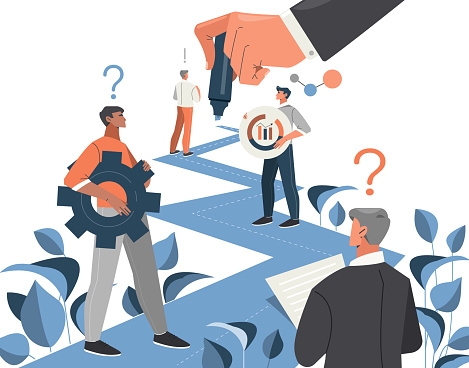
The Value of Getting Website Personalization Right Within The Technology Industry
Jaime Escott - 7 Min read

Most of our experiences in today’s world are personalized, from your morning coffee order down to the spam in your inbox. Website personalization is becoming more and more popular as businesses scramble to find ways to stand out from the competition. But it is not just a marketing trend to soon be replaced by the next fad. More than just a buzzword, this strategy is changing the game for B2B and B2C companies alike.
Don’t forget, B2B buyers are also daily consumers. They know how businesses target them as customers online and they now expect to receive the same types of user experience in their professional lives. This means there are significant — and untapped — opportunities for early adopters when it’s implemented thoughtfully. Real-time website personalization can give technology companies a serious edge, allowing them to increase conversion rates, engagement, loyalty, and target their customers with the resources and information that are relevant and interesting to each unique prospect. Increasingly, campaigns and websites with a one-size-fits-all approach just aren’t cutting it and research has proven that personalization can deliver impressive results.
But like all marketing techniques, great reward only comes to those who use the technique strategically. Too often the marketing technology is wasted on gimmicky personalization just to demonstrate its feasibility rather than drive results. In this article, we’ll dive into strategic website personalization and the benefits it can reap for technology and your audience.

What is personalization?
Personalization is the collection of user data such as geolocation, site behavior, past purchases, uncompleted goals, etc., and applying it to create tailored experiences on mobile apps, emails, digital ads, and websites. Not to be confused with customization or individualization, website personalization is dynamic content that creates more relevant experiences for various audience segments that feels in line with what they are seeking and interested in.
How is it done?
While businesses may all have a similar objective, e.g., increase revenue, not all use cases are created equal. What may be an effective CTA or image to personalize on one website may not mirror the same benefits for another. Keeping your business goals top of mind while beginning your website personalization journey will help to steer you away from gimmicky updates and keep your tactics aligned with your overarching objectives. Strategizing and implementing custom web experiences that directly correlate with your business goals will take your website and user experience to the next level.
Benefits of website personalization
Customers place a high value on companies that make them feel appreciated and acknowledge their distinct interests, desires, and motivations. As a result, marketers are turning to personalization to better predict and respond to customers’ needs. When used effectively, website personalization can be a powerful tool for driving growth and success in the technology industry. After reviewing your business objectives, you can select website personalization tactics that will soothe your pain points and bring you closer to priority goals such as increased conversion rates and an improved user experience.

Increase Conversion Rates
A major benefit of website personalization for companies within the technology industry is its ability to increase conversion rates and goal completions across the website. Your website's landing pages are often your first impression to new users, and customized experiences may help you to stand out. Customizing content by incorporating personalized touches along their entire user journey will guide users to the actions you want them to complete in order to convert them into leads.
Improve User Experience
An improved user experience paired with relevant content can guarantee lower bounce rates and extended session duration - all of which will bring you more website visitors. With today’s continually shrinking attention spans (Learn more about the impulse generation) it’s more crucial than ever that users can find what they are looking for intuitively and quickly, otherwise they’ll look elsewhere. Implementing website personalization to suggest relevant content based on their user data will ensure your leads are being properly nurtured and increases their chances of entering your sales funnel. Segmenting the content on your website based on previous searches and clicks will allow you to present users with the information they have been looking for right as they enter your site- creating a streamlined and more personal experience for the user.

Below are some of the touch points on a user journey that could be strategic for your company to personalize:
-
Relevant product recommendations
Personalizing your purchase recommendations satisfies user’s need to find their solution quickly and with ease. This is especially crucial if your business offers a wide variety of products or services, as no one wants to dig through a massive content library or page after page of products that aren’t relevant to them. Website personalization helps you provide accurate and relevant recommendations to users based on their past website visits and behavior. You can leverage the data you collect to make sure the product recommendations are always fresh and quickly make quality recommendations to site viewers. Use your customer data to recommend the product categories or industries they care about. This will not only keep users from abandoning your site, but your website time spent can be increased, customer loyalty can be enhanced, and a higher retention rate can be achieved.
-
More effective retargeting
Retargeting campaigns offer incredible opportunities when you combine them with personalization. It is natural for users to consume the most relevant pieces of content in front of them and past customers, or users who have spent a significant amount of time engaging on your website, have handed you valuable data on the products and information they are interested in. Utilizing that information to continue to nurture them will not only help build engagement but also drive conversions. This data can be used to personalize landing pages when users return, create relevant ads based on previous purchases or content engagement, or ads to drive them back to your site. If your visitors are more engaged, they will be more likely to buy again. This means you can make a difference in your business.
-
Dynamic CTAs
Additionally, while a carefully crafted CTA might entice a large number of your audience, it’s unlikely that it fulfills the purpose of every visitor. Having dynamic CTAs that cater to users depending on their place in their user journey will guarantee better conversion rates and help guide them quickly down the funnel. For example, a user visiting your site for the first time is likely in the research stage and is looking to find out more about your company. In this instance, a ‘Learn More' or ‘View our products” will lead them to exactly the content they were looking for. In opposition, a returning user who is not yet a customer already knows what you offer so they’re more likely to engage with a CTA such as ‘view testimonials’ or "watch demo". This is giving them the nurturing they need to be convinced of your value. HubSpot’s study of over 330,000 calls to action shows that smart CTAs have conversion rates far above the average, converting 202% better than default versions.

Image source: hubspot
-
Improve lead nurturing
By personalizing the user experience and collecting accurate, useful data along the way, you can be very strategic about your touchpoints throughout each lead’s sales cycle. Personalization allows you to segment your target audiences more meaningfully and continue messaging prime prospects at multiple digital touchpoints, knowing what information they are looking for at that time. You can maintain high-quality content distribution based on browser history, website clicks, or page views, or even fence particular content pieces to collect more information that will assist your marketing and sales teams narrow down prospects and complete transactions faster. For example, if a user fills out a form to download an eBook about lowering costs when implementing your product, you can enroll them in a drip campaign to provide additional information on the subject, such as a pre-recorded webinar, success story examples, infographics, or even a recent podcast your team recorded on the subject.

Time and time again research has shown us that website personalization is extremely effective in increasing conversion rates, engagement, and loyalty. However, the technology industry has long struggled with how to deliver personalized, relevant solutions to B2B professionals. Seeking assistance from a team with expansive knowledge in creating world-class digital experiences within the tech industry can help you navigate through the process with ease. Investing in digital experiences and adopting a human-centric mindset will open new opportunities for life science brands to deepen their relationships with customers and utilize data for actionable and effective patient insights.